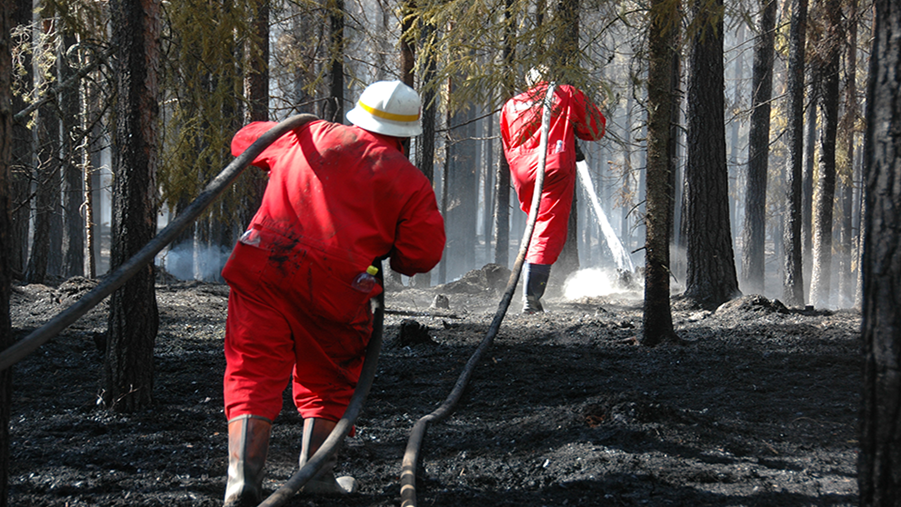
How should we use the land?
Seventy-two per cent of the earth's land area is used. How should we optimise its use to ensure sustainable development?

Is there a change in amount of forest fires and fire-pattern over time? What has caused forest fires, today and in the past? Researchers Mats Niklasson and Peter Holmgren give us the answers.
Land and forest fires occur all over the world. The last years we have seen alarming reports of forests on fire in California, Brasil and Australia. Broadly speaking, forest fires can be divided in two kinds; ground fires and crown fires. Ground fires burn the ground and surface litter with flames one to two metres high. Crown fires burn the entire layer of tree crowns and the ground with high intensity, with flames up to 30 metres high. Apart from forest fires, large expanses of savanna and farmland are burned every year, usually to prepare the land for pasture or crops. Every year, up to 3% of the world's land area is burned in one of these ways. In Sweden, just 0.16 per mille is burned a year on average, which is extremely low compared to pre-industrial time.
Fires are fundamentally a completely natural phenomenon, according to Mats Niklasson, Associate Professor in forest vegetation ecology at the Swedish University of Agricultural Sciences in Alnarp, southern Sweden:
"In terms of evolution, the forests have been shaped by fires over millions of years. Ever since Earth has had an atmosphere there have been electrical discharges, and the resulting lightning has caused fires."
Several ecosystems, such as coniferous forests, have had a strong mark made on them by fires. The Scots pine is well adapted to fire and is better at surviving than the Norway spruce thanks to its thick bark. Still today there are a few unpopulated areas in the world that have forest fires regularly, such as East Siberia and parts of Canada; fires in these places burn until the rain puts them out.
When humans began using fire to clear farmland and pasture, set fires became more common than those caused by lightning.
"For a few thousand years, burn-beating was very common in the Nordic countries to create farmland and early succession of grass and bushes for livestock. The forests of northern Sweden burned every 30 to 100 years either due to burn-beating or lightning, and fires in the southern part of the country were even more frequent," says Niklasson.
The European industrialisation increased the demand for timber and the forests received greater financial value. In the late 19th century forestry, or silviculture, came along and the focus was now on protecting it and fighting any fires that started. Before the fires were fought, an estimated 1–2% of Sweden's land surface burned annually, compared to about 0.16 per mille today. Fire-fighting has been very successful.
The causes of forest fires today vary around the world. The main causes in Europe are neglect or deliberate intent, assisted by drought, heat and wind. These kinds of fires are common in Australia and western North America, where forest with highly inflammable debris on the ground and close to towns and homes increase the risks.
"In Sweden, only the forest's surface litter tends to burn. Crown fires are unusual, but the 2014 wildfire in Sala and the ones in Dalarna and Hälsingland provinces in 2018 were largely crown fires. In contrast, Mediterranean countries such as Spain and Portugal, with their drier regions, often suffer much more far-reaching crown fires with far more dramatic progressions."
Rapid urbanisation in Europe is also a contributing factor: farms are left, fields become overgrown, and the resulting bush forests can easily burn. Peter Holmgren is a forest specialist and former Director-General of the Center for International Forestry Research (CIFOR), and has also headed up FAO's global work on climate change. He says that unmanaged land entails a higher risk of fire than managed land. In large parts of Africa, South America and southern Asia, however, fire is still mainly used to clear or prepare land areas:
"It is a tried and tested method, one that's cheap and simple to deploy, just like we used to do. However, as agriculture becomes increasingly efficient and large-scale, we're starting to see a decline in the practice worldwide," Holmgren explains.
The downside of forest fires is of course the danger they present to people, homes and buildings. They can also generate severe air pollution and carbon dioxide emissions. On the upside, they are Mother Nature's own way of managing the forest ecosystem, favouring species that rely on fires to reproduce.
"Thousands of species in Sweden depend on fires in some way, and about 100, mainly insects, are completely dependent on them. Conservation burning has also returned and has been practised since the early 1990s, both in and outside of reserves," says Niklasson.
So what are the effects of forest fires in terms of sustainable development, in addition to those outlined above? The wildfires in the Amazon have been much talked about, where they are a consequence of deforestation, as Holmgren explains:
"Deforestation is the basic problem in the Amazon, where forests are burned to clear land for pasture, or to grow soybeans or maize. In the news reports of summer 2019, it was soon hard to pick out the facts, everything became so weighted. Were the fires in the Amazon, or all over Brazil? What was the difference compared to the previous year? How big a factor was the general political debate in the reporting? It is a fact though that both deforestation and too many fires in farming create problems, especially air pollution."
Storgatan 19
Stockholm
Box 55525, 102 04 Stockholm, Sweden
+46 (0)8-762 72 60
We use cookies to improve your browsing experience (Swedish text)
Privacy policy (Swedish text)